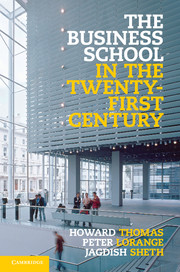Book contents
- Frontmatter
- Contents
- List of figures
- List of tables
- Preface: Tipping or tripping? The business school and its dilemmas
- Acknowledgements
- 1 The business school: history, evolution and the search for legitimacy
- 2 Business school identity and legitimacy: its relationship to the modern university and society
- 3 Rethinking management education and its models: a critical examination of management and management education
- 4 A framework for re-evaluating paradigms of management education
- 5 Evaluating new and innovative models of management education
- 6 Is the business school a professional service firm? Lessons learned
- 7 Enhancing dynamic capabilities in the business school: improving leadership capabilities in curricula and management
- 8 Afterword: business school futures
- Index
- References
4 - A framework for re-evaluating paradigms of management education
Published online by Cambridge University Press: 05 July 2013
- Frontmatter
- Contents
- List of figures
- List of tables
- Preface: Tipping or tripping? The business school and its dilemmas
- Acknowledgements
- 1 The business school: history, evolution and the search for legitimacy
- 2 Business school identity and legitimacy: its relationship to the modern university and society
- 3 Rethinking management education and its models: a critical examination of management and management education
- 4 A framework for re-evaluating paradigms of management education
- 5 Evaluating new and innovative models of management education
- 6 Is the business school a professional service firm? Lessons learned
- 7 Enhancing dynamic capabilities in the business school: improving leadership capabilities in curricula and management
- 8 Afterword: business school futures
- Index
- References
Summary
INTRODUCTION
The previous chapter addressed the many challenges facing the context and relevance of management education and emphasised the importance of re-evaluating and rethinking existing models. This chapter tries to provide some benchmark information and a set of guidelines and general principles for improving management education based on our collective experience. It adds to the Lorange model (see pp. 123–34) with one developed by Professor Jagdish Sheth that outlines an interactive framework detailing the ‘bad habits’ of business schools and examining how they should then embrace the opportunities provided by the changing business environment.
This is followed in Chapter 5 by an evaluation and analysis of a number of innovative new models of management education using the Sheth framework and the results from a recent study of new MBA models carried out by Professor Datar and his colleagues at Harvard Business School (Datar et al., 2010).
THE SHETH MODEL FRAMEWORK
Since the financial crisis of 2008, business as a capitalist institution has received much criticism, especially with respect to its obsessive focus on creating shareholder value as opposed to shared value (Porter and Kramer, 2011; Currie et al., 2010). By association, business and management education, as indicated earlier, has also come under criticism about its relevance, purpose, mission and curriculum, and about its teaching, research and service outcomes.
- Type
- Chapter
- Information
- The Business School in the Twenty-First CenturyEmergent Challenges and New Business Models, pp. 137 - 166Publisher: Cambridge University PressPrint publication year: 2013

